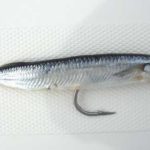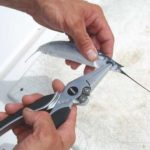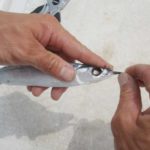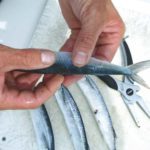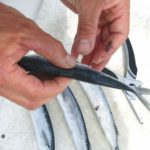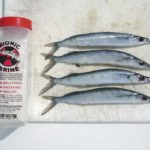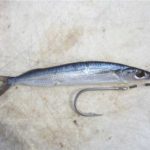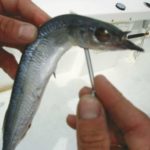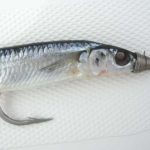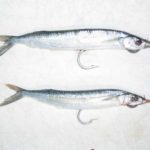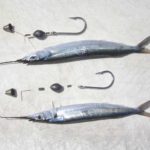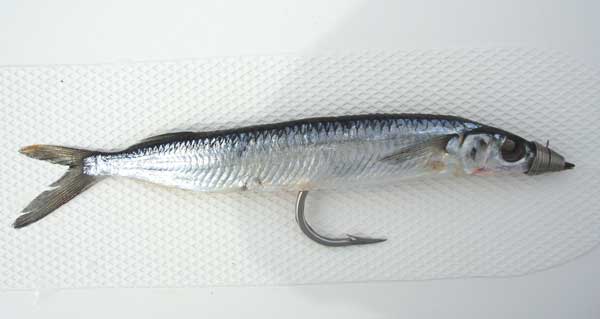
Using the real stuff will increase your offshore bites. Here’s how to get rigged right.
Traveling to Venice from Hawaii, John Guinan and his dad were anxious to sample some of the world-class bluewater fishing they had heard about just off the Louisiana coast. With the wide-open dolphin bite in May, Capt. Bill Delabar knew just the ticket to get their trip started as he headed for bluewater and a rip that had formed up just south of one of the floater rigs.
Delabar’s mate deployed a swimming ballyhoo that he had expertly rigged on the ride out. Only a few moments passed before a big dolphin streaked from beneath a mat of sargassum. Like a neon sign, it flashed and changed colors from blue to yellow to green as it grabbed the ballyhoo.
The beautiful fish jumped and flipped tail over head as it tried in vain to throw the hook.
“We have plenty of mahi-mahi in Hawaii, but you have so many of them here,” said Guinan as he posed for a photo and admired the 30-pound cow on the gaff.
Dolphin are but one of many species that can be tempted with a ballyhoo pin rig. Marlin, wahoo and sailfish are other species that will engulf a properly rigged ballyhoo. Oftentimes when a fish will snub its nose at plastic or hard baits, it can be tempted with properly rigged natural baits.
With the help of local charter captains who use these methods often, Louisiana Sportsman has outlined step-by-step instructions for two of the more popular natural bait rigs, along with tips and supplies needed to get started.
Bait selection
Bait selection is a very important step in the process.
“The quality of the bait you start with is the limiting factor to successfully rigging a ballyhoo,” Delabar explained.
When using frozen ballyhoo, it is often necessary to sort through several packages to ensure the ones you pick are the best. When shopping for baits, customers should look for ballyhoo that are vacuum-packed. The skin should be blue, and the skin and scales should be intact. Also examine the packaging to ensure that the baits are adhered to the plastic. Baits that are not stuck to the packaging could indicate that they have been previously thawed and refrozen, which will result in baits that are mushy and will not last.
If fresh ballyhoo are available, by all means take advantage of those. They can be caught by using small sabikis.
“Take extra care not to knock scales off of the ballyhoo or damage the skin. Your natural bait rig is only as good as the bait you start with,” said Delabar.
If you have fresh ballyhoo, they tend to be much more forgiving during the handling and rigging process. The more times a ballyhoo has been thawed and refrozen, the more careful you need to be when handling and rigging them.
Bait preparation
Start by removing the eyes from the ballyhoo by pushing a small wooden dowel or the points of pliers through both eye sockets.
Grasp the beak of the ballyhoo and snap it off about ½ inch above the end of the upper jaw.
Break the backbone by gently pinching starting at the pectoral fin and ending near the dorsal close to the tail.
Note: If working with old, poor-quality baits, simply flex the ballyhoo working it back and forth to limber the bait instead of breaking the backbone. This method should be used when it is evident that breaking the backbone will destroy the skin of the ballyhoo.
Using two fingers, gently squeeze the lower half of the ballyhoo, working to expel the contents of the intestinal cavity.
Gently rinse with water, and place baits in a single layer on a tray or inside a clean ice chest. Coat with brine, and cover with a layer of ice. Ideally, baits should be allowed to soak overnight. Brining the baits helps to toughen them, which results in longer-lasting baits.
Ballyhoo charter pin rig
The advantages of this rig are that it is very easy and fast, and can be done quickly while on a boat. The disadvantage is that it limits the ways the bait may be rigged and how it is going to swim. Since a bait spring is employed, it does not secure the ballyhoo to the rig as well as other methods of rigging such as copper wire.
The main component of this style of rigging is the bait spring. C&H offers these in medium and large sizes. The bait springs are readily available at local fishing tackle outlets such as Puglia’s and Professional Sport Shop as well as through mail order tackle catalogs such as Offshore Angler and Capt. Harry’s.
Delabar uses 130-pound FRENZY fluorocarbon on his naked ballyhoo rigs from late spring into early summer when he feels a more stealthy presentation is required to get bites.
Step-by step pin rig:
Select a 7/0 to 9/0 hook of your preference (match hook size to the size ballyhoo you are using). Needle eye hooks are preferable, but sometimes they are hard to find.
Select a 4- to 5-foot section of 200-pound leader material appropriate to the type of fishing you plan to do. You want to be able to reel the swivel to the rod tip in order to gaff the fish.
Try to match the crimp as close as possible to your leader size because making a poor connection at the crimp can drastically reduce the breaking strength of the leader.
Slip the larger crimp on first, then the weight then the crimp that is matched to your leader size, followed by the hook. Line is doubled and passed through the weight, where a slightly larger second crimp finishes off the rig. It is important that the line comes out the bottom of the crimp and the pin can be bent and inserted opposing the hook and out through the beak or nose of the ballyhoo.
When using a chin weight for a swimming ballyhoo, select lighter and slimmer-profile style weights.
“The bigger the weight, the dumber the mate” is an old saying heard around the docks.
Rigging a swimmer
The pin goes through both jaws, and provides the anchor point from which the whole rig is pulled
“While rigging, try to close up the bait as much as possible to prevent water flow,” Delabar suggested. “This provides longevity by helping to keep the bait from washing out.
“When you finish rigging the bait, pull on the leader. If the hook moves at all, the bait will most likely spin. Any movement of the hook indicates that the rig is being pulled by the hook and not the pin. If the bait spins when deployed behind the boat, take it out of the water, make a small slit just forward of the hook and try it again.
“The most important detail in fishing with ballyhoo is that it swims straight. It is vital that this is checked as the baits are being put out. I can’t stress this enough.”
Having said that, however, Delabar starts with as small a slit as possible to avoid washing out the bait.
Copper-wire rig
The advantage of the copper wire rig is that is more durable. It offers a more-secure connection for times when the ballyhoo is being attacked — for example, when a pack of small dolphin comes out and nips at the baits. This gives anglers a chance to quickly pull the ballyhoo away and to save the bait before it is pulled off.
There are disadvantages to this type of bait rigging, however, as it takes longer to rig on the boat, making it tough on captains who fish without a mate.
Secondly, copper is expensive and prices continue to rise.
The first two wraps go on either side of the pin and over the top lip. These wraps secure the nose of the ballyhoo to the rig and shut the mouth to stop water flow.
The third wrap goes through the open eye socket and under the gill.
Note: When a chin weight is used, extra care is taken in this step to secure the weight into the recess in the throat using an extra wrap through the eye socket at either end of the weight.
The next wrap goes around the outside of both gills and makes one complete wrap around the ballyhoo, and is cinched tight. This further closes off water flow to help keep the bait from washing out.
Finally, pass the wire back through the eye socket, and find its way back over the pin.
The remainder of the wraps finish off the connection. Continue closing off the mouth and working down the bill, making sure the leader is kept running perfectly straight along the bottom of the bill.
At the end of each step, snug the copper wire. When done correctly, this method will not only produce the best swimming action for your bait, but also works to prevent water flow within the bait itself which helps the bait to continue to swim true and ultimately keep from washing out.
Slip a brightly colored blue or pink Ilander over the top for a winning combination.
For tournament anglers, the rigging process just got a little tougher. Circle hooks are required when fishing with natural bait to help cut down on billfish mortality due to gut hooking.
Section 635.2 reads: “After Dec. 31, 2007, persons who have been issued or are required to be issued a permit under this part and who are participating in a tournament, as defined in §635.2, that bestows points, prizes or awards for Atlantic billfish must deploy only non-offset circle hooks when using natural bait or natural bait/artificial lure combinations, and may not deploy a J-hook or an offset circle hook in combination with natural bait or a natural bait/artificial lure combination.”
The Cajun Canyons Billfish Classic slated for late May will be among the first to test this new rule locally. It’s time to practice those bait-rigging techniques before the big event.
